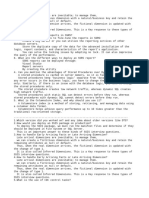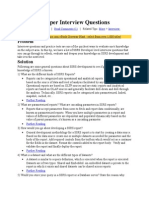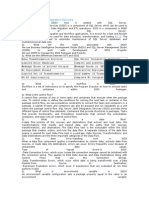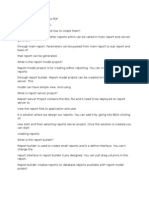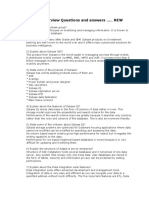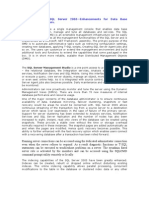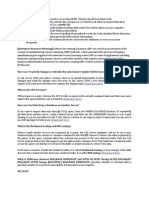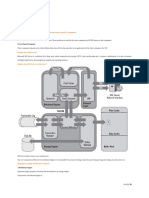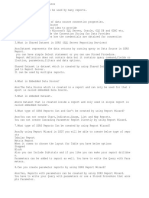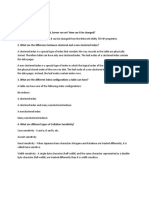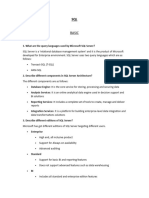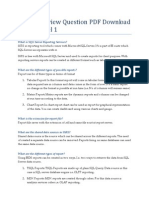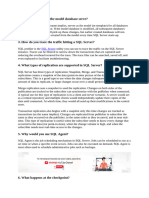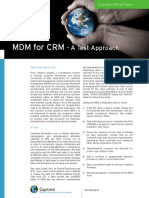Certification Notes
Certification Notes
Uploaded by
jyothipuvvu04Copyright:
Available Formats
Certification Notes
Certification Notes
Uploaded by
jyothipuvvu04Original Title
Copyright
Available Formats
Share this document
Did you find this document useful?
Is this content inappropriate?
Copyright:
Available Formats
Certification Notes
Certification Notes
Uploaded by
jyothipuvvu04Copyright:
Available Formats
Following are the important architecture components of SSRS:
Report Designer
Report Manager
Report Server
Report Server Database
Browser types supported by reporting services
Report Server and Command line utilities
---------------------
SQL Server
----------
SSIS
How would you deploy an SSIS package on production?
To deploy the SSIS package, we must run the manifest files and determine if they
should be deployed in File System or SQL Server.
This is an important answer to these kinds of SSIS interview questions.
3.How to handle Early Arriving Facts or Late Arriving Dimension?
Late arrival dimensions are inevitable; to manage them,
we can create a fictitious dimension with a natural/business key and retain the
remaining attributes as null or default.
Thus, when the real dimension arrives, the fictional dimension is updated with
the change of type 1.
It is also called Inferred Dimensions. This is a Key response to these types of
SSIS interview questions.
4.How to handle Early Arriving Facts or Late Arriving Dimension?
Late arrival dimensions are inevitable; to manage them.
we can create a fictitious dimension with a natural/business key and retain the
remaining attributes as null or default.
Thus, when the real dimension arrives, the fictional dimension is updated with
the change of type 1.
It is also called Inferred Dimensions. This is a Key response to these types of
SSIS interview questions.
5.What is the use of CDC control tasks?
By using CDC, we can maintain and interact with the SQL Server change capture
function.
` is an important answer to these kinds of SSIS interview questions.
6.Explain How Can You Do An Incremental Load?
7.How do you store SQL passwords? Does the SSIS connection manager of the package
store SQL password?
8.What is CDC Splitter?
Once the data is read into a table with CDC enabled, this transformation sends the
data that should be deleted, inserted,
and updated in a different path. This is a Key response to these types of SSIS
interview questions.
1. What are the essential architecture components of SSRS?
Following are the important architecture components of SSRS:
Report Designer
Report Manager
Report Server
Report Server Database
Browser types supported by reporting services
Report Server and Command line utilities
Data Sources
2. Explain the various stages of Report Processing
The various stages of Report Processing include:
Compile: It analyses the expressions in the report definitions and saves the
compiled intermediate format on the server internally.
Process: It executes dataset queries and combines intermediate format with
layout and data.
Render: It sends a processed report to a rendering extension to display how
much information can fit on each page and then creates the page report.
Export: It exports reports to a different file format.
3. What is Tablix in SSRS?
The Tablix is a sum of the tables with matrices in SSRS.
Each report that we create using the SSRS technology is based on the Tablix data
region.
In other words, a Tablix can be managed with the collective capabilities of a
matrix and a table.
4. What is the role of a report manager in SSRS?
In SSRS, a report manager is a web application in SSRS that can be accessed by a
URL.
The report manager interface depends on the user permissions.
This means that the user must be allocated a role to access any functionality or
execute any task.
A user assigned the role of full permission can manage all the menus and
features of the report.
A URL must be defined to configure the report manager.
5. How can we fine-tune reports in SSRS?
Following are the steps to fine-tune the reports in SSRS:
Create a big server or you can utilize the reporting services of other
database servers.
Store the duplicate copy of the data for the advanced installation of the
logic, report contents, and characteristics of the report's application.
You can solve the locking issues by adopting no lock. It can also improvise
the query of the performance.
6. What are the different ways to deploy an SSRS report?
SSRS reports can be deployed through:
Visual Studio
Report servers
By creating the utility
7. Explain what is the difference between Tabular and Matrix report?
A tabular report is a simple, organized report that displays data in a tabular
format, similar to a spreadsheet.
It is useful for displaying data in a simple, organized manner.
A matrix report, also known as a crosstab report, displays data in a grid
format.
It is useful for comparing data across multiple dimensions and categories.
8. What is an Ad Hoc Report?
It is designed to meet the user's specific needs and can be customized as
needed.
Ad Hoc reports are created using a drag-and-drop interface, allowing users to
quickly create reports without needing technical expertise.
1. How can you compare the Local and Global Temporary tables?
Local temporary tables are visible only to the table creators when connected
with an SQL instance.
The tables will be deleted once the user disconnects the SQL instance.On the
other hand, global temporary tables are visible to any user.
These tables are deleted only when any user referencing these tables gets
disconnected from the SQL instance.
2. How can you distinguish between SUBSTR and CHARINDEX?
Given the starting position and length details, SUBSTR helps extract a substring
from the specified string.
The syntax for this function is given by: SUBSTRING (expression,
starting_position, length)
On the contrary, the CHARINDEX function helps identify a substring's position
from the specified string.
The syntax for this function is given by:CHARINDEX (substring, input_string)
3. the difference between Clustered Index and the Non-clustered Index?
6. How to improve query performance in SQL server?
Defining the transaction requirements precisely
Choosing the right query execution plan
Reducing table sizes and simplifying joins
Using ‘SELECT fields FROM’ instead of ‘SELECT*FROM’
Using EXIST() instead of COUNT()
Creating SQL query indexes
Avoiding running queries in loops
7. Differentiate EXCEPT and INTERSECT commands?
These commands are used to return distinct rows by comparing the results of two
separate queries.
EXCEPT: operator allows returning distinct rows from the left input query only.
INTERCEPT: operator allows returning distinct rows from both left and right
input queries.
8. What is the difference between ORDER BY expression and clustered index?
ORDER BY expression sorts the result set of a query as per the condition given
in the statement. It can sort the result set either in ascending order or
descending order. And, it can sort the result set based on attributes given in the
statement such as country, company, etc. At the same time, clustered index sorts
data physically only in a specific way in the table. So, every table will have one
clustered index only.
9. How can you improve the performance of stored procedures in the SQL server?
Using SET NOCOUNT ON messages, information messages can be prevented from the
result set. It will reduce network traffic and increase operational performance.
When fully qualified procedure name, the SQL server finds the compiled plan
quickly, which in turn increases the performance
Specifying stored procedures as sp_procedurename must be avoided because the SQL
server will search the master database first if it finds ‘sp’ in the procedure
name. It would decrease the performance and yield error results at times.
Transactions need to be shorter so that deadlocks and blocking can be prevented.
You might also like
- D108650GC10 - sg1 Oracle Database 19c PLSQL Workshop Vol 1Document478 pagesD108650GC10 - sg1 Oracle Database 19c PLSQL Workshop Vol 1johnroberts135492% (12)
- 2 Vinaytech Power Bi Basic Practicals All FeedsDocument40 pages2 Vinaytech Power Bi Basic Practicals All FeedsSsNo ratings yet
- Data AnalysisDocument3 pagesData Analysisjyothipuvvu04No ratings yet
- Engineering Summary NotesDocument3 pagesEngineering Summary Notesjyothipuvvu04No ratings yet
- Exam QuestionsDocument4 pagesExam Questionsjyothipuvvu04No ratings yet
- EXAM Test PapersDocument4 pagesEXAM Test Papersjyothipuvvu04No ratings yet
- Java Exam NotesDocument4 pagesJava Exam Notesjyothipuvvu04No ratings yet
- FinanceDocument3 pagesFinancejyothipuvvu04No ratings yet
- MaterialDocument4 pagesMaterialjyothipuvvu04No ratings yet
- Class NotesDocument3 pagesClass Notesjyothipuvvu04No ratings yet
- Theory Notes MaximaDocument3 pagesTheory Notes Maximajyothipuvvu04No ratings yet
- In This Section I Will Give You Fairly Long List of Short and Narrowed QuestionsDocument15 pagesIn This Section I Will Give You Fairly Long List of Short and Narrowed QuestionsPrabhakar ReddyNo ratings yet
- SSRS ReportsDocument4 pagesSSRS ReportsShaik AbdullaNo ratings yet
- SSRSDocument21 pagesSSRSRajNo ratings yet
- SSRS Developer Interview Questions-IMPDocument4 pagesSSRS Developer Interview Questions-IMPexbisNo ratings yet
- SSISDocument100 pagesSSISHimanshu ChauhanNo ratings yet
- SSISDocument99 pagesSSISsekhar19820% (1)
- SSRS Interview Questions (1) .OdtDocument11 pagesSSRS Interview Questions (1) .OdtravikumarNo ratings yet
- SSRS Interview Questions PDFDocument11 pagesSSRS Interview Questions PDFJaya KumarNo ratings yet
- Difference Between Informatica VersionsDocument5 pagesDifference Between Informatica VersionsvalladiNo ratings yet
- SQL Server DBA Interview QuestionsDocument10 pagesSQL Server DBA Interview QuestionsBirendra PadhiNo ratings yet
- Business Intelligence: Explain The Architecture of SQL Reporting ServiceDocument18 pagesBusiness Intelligence: Explain The Architecture of SQL Reporting Servicejanakiram77No ratings yet
- Dot Net Interview Q & A 5Document6 pagesDot Net Interview Q & A 5Azhag ArasuNo ratings yet
- SQL Technical INterview PDFDocument13 pagesSQL Technical INterview PDFGuru100% (1)
- Information Practice Project Spots Shop Management SystemDocument51 pagesInformation Practice Project Spots Shop Management SystemAbhishek Kumar59% (49)
- SSRS Interview QuestionsDocument6 pagesSSRS Interview QuestionsRaavi ChowdaryNo ratings yet
- SQL Server Reporting ServicesDocument3 pagesSQL Server Reporting ServicesAbhishek MitraNo ratings yet
- Bi QuestionsDocument13 pagesBi QuestionsHii ThereNo ratings yet
- Sybase Interview Questions and Answers ..... NEWDocument7 pagesSybase Interview Questions and Answers ..... NEWaadityaskr1100% (1)
- DBCC, DMVs and PT Q&ADocument12 pagesDBCC, DMVs and PT Q&AAsim KhanNo ratings yet
- Command Line Utilities in SSRS 2008Document8 pagesCommand Line Utilities in SSRS 2008rajesh.khannaNo ratings yet
- What's New in SQL Server2005Document3 pagesWhat's New in SQL Server2005Amit RastogiNo ratings yet
- Read More HereDocument5 pagesRead More HereShivakumar S KadakalNo ratings yet
- SQL Server 2008 Reporting ServicesDocument130 pagesSQL Server 2008 Reporting ServicesDjord AndraNo ratings yet
- SQL Server Reporting ServicesDocument24 pagesSQL Server Reporting ServicesRupesh BansalNo ratings yet
- DR Reporting Made Easy With Report Builder 3.0Document132 pagesDR Reporting Made Easy With Report Builder 3.0robertorojasfeijoNo ratings yet
- What Is The Difference Between Product Based and Service Based IT Companies?Document36 pagesWhat Is The Difference Between Product Based and Service Based IT Companies?gopinath_150840358No ratings yet
- SSRSDocument4 pagesSSRSManzar AlamNo ratings yet
- Interview Question AnswerDocument12 pagesInterview Question AnswerrajeevtyagiNo ratings yet
- SsisDocument25 pagesSsisSandy AtlNo ratings yet
- SQLDocument12 pagesSQLberoye1833No ratings yet
- SSRS Interview Question and Answers Basics Part 1Document3 pagesSSRS Interview Question and Answers Basics Part 1Venkat RatnakaramNo ratings yet
- ReportDocument26 pagesReportalok nayakNo ratings yet
- SQL Server Research PaperDocument5 pagesSQL Server Research Paperpqltbarif100% (1)
- DBMSDocument34 pagesDBMSFake IDNo ratings yet
- PBI QuestionsDocument4 pagesPBI QuestionsSaurabh singhNo ratings yet
- SQLDocument10 pagesSQLaccinterview2No ratings yet
- SQL 2008 DbaDocument314 pagesSQL 2008 Dbavaddesuresh100% (1)
- 000 Basics and IntroductionDocument7 pages000 Basics and IntroductionsureshtNo ratings yet
- 100 SQL Server Mistakes and How To Avoid ThemDocument131 pages100 SQL Server Mistakes and How To Avoid Themwachiramaina1313No ratings yet
- SQL Server DBA Interview Questions and Answers: AnswerDocument13 pagesSQL Server DBA Interview Questions and Answers: AnswerMehul PrajapatiNo ratings yet
- Reporting Services 2014 PDFDocument130 pagesReporting Services 2014 PDFAna B. Lima L.No ratings yet
- A Interview Questions and Answers - Cool InterviewDocument30 pagesA Interview Questions and Answers - Cool Interviewcm_ram847118100% (16)
- SSIS Interview Questions & AnswersDocument45 pagesSSIS Interview Questions & Answersanandpremk100% (2)
- Advanced SQL Performance Tuning: Optimize Your Database WorkloadsFrom EverandAdvanced SQL Performance Tuning: Optimize Your Database WorkloadsNo ratings yet
- SQL Server Query Tuning and Optimization: Optimize Microsoft SQL Server 2022 queries and applicationsFrom EverandSQL Server Query Tuning and Optimization: Optimize Microsoft SQL Server 2022 queries and applicationsNo ratings yet
- SQL Built-In Functions and Stored Procedures: The i5/iSeries Programmer's GuideFrom EverandSQL Built-In Functions and Stored Procedures: The i5/iSeries Programmer's GuideNo ratings yet
- High Performance SQL Server: Consistent Response for Mission-Critical ApplicationsFrom EverandHigh Performance SQL Server: Consistent Response for Mission-Critical ApplicationsNo ratings yet
- MS Access NotesDocument34 pagesMS Access Notesmukundinemadzhilili26No ratings yet
- Mysql Create Table ExercisesDocument9 pagesMysql Create Table ExercisesKhaing Moe SanNo ratings yet
- Java Database Connectivity - JDBC NotesDocument18 pagesJava Database Connectivity - JDBC NotesMuhammad Rana FarhanNo ratings yet
- How To Start Your ProjectDocument12 pagesHow To Start Your ProjectNza HawramyNo ratings yet
- Temenos Application Framework JAVA T - T24: EmenosDocument51 pagesTemenos Application Framework JAVA T - T24: EmenosHareesh100% (2)
- SQL Injection and FriendsDocument8 pagesSQL Injection and FriendsSANLU HTUTNo ratings yet
- SQL Join SummaryDocument1 pageSQL Join SummaryQuang VoNo ratings yet
- Unit-1 DWDMDocument20 pagesUnit-1 DWDMsanjayktNo ratings yet
- AdgrantsDocument13 pagesAdgrantspepepekasNo ratings yet
- MDG 8.0 Consolidation GuideDocument47 pagesMDG 8.0 Consolidation Guidepopol popolNo ratings yet
- Piconnect Con PhytonDocument46 pagesPiconnect Con PhytonMiguel AngelNo ratings yet
- Software Architecture and Design For PatientDocument40 pagesSoftware Architecture and Design For PatientmisganaNo ratings yet
- 02 Relational-Model PrintDocument26 pages02 Relational-Model PrintMustafa BilginNo ratings yet
- SP3D AdminDocument4 pagesSP3D AdminSivashankar NNo ratings yet
- 2ndyear COMPS GTU - QBanksDocument2 pages2ndyear COMPS GTU - QBanksDharmik PajwaniNo ratings yet
- Windows Abused PrivilegesDocument1 pageWindows Abused PrivilegesRed GreyNo ratings yet
- Informatics Practices: T C XiDocument10 pagesInformatics Practices: T C XioptionsNo ratings yet
- B.E / B.Tech./B.Arch. Practical End Semester Examinations, April / May 2021Document5 pagesB.E / B.Tech./B.Arch. Practical End Semester Examinations, April / May 2021Ramkumar RamakrishnanNo ratings yet
- PoT - Im.08.1.059.05 PresentationsDocument76 pagesPoT - Im.08.1.059.05 PresentationsVishal PathakNo ratings yet
- Spotify ComboDocument78 pagesSpotify ComboJuan MeloNo ratings yet
- еучнDocument9 pagesеучнАлмас БейсебаевNo ratings yet
- MYSQL STRING FUNCTIONS by Wadie BelghitiDocument27 pagesMYSQL STRING FUNCTIONS by Wadie BelghitihangryNo ratings yet
- Answers - OS LAB QUIZDocument8 pagesAnswers - OS LAB QUIZadNo ratings yet
- PL-SQL Content by CetpaDocument2 pagesPL-SQL Content by CetpaRam Avtar GuptaNo ratings yet
- MDM For CRM A Test ApproachDocument9 pagesMDM For CRM A Test ApproachPrakashNo ratings yet
- Elastic Search PresentationDocument55 pagesElastic Search PresentationMustafa ShaikhNo ratings yet
- Fall 2023 - CS619 - 8922 - 29254 - F2302953EFDocument14 pagesFall 2023 - CS619 - 8922 - 29254 - F2302953EFZainab zulfiqarNo ratings yet
- IBM DATASTAGE Online Training, Online Datastage TrainingDocument5 pagesIBM DATASTAGE Online Training, Online Datastage TrainingMatthew RyanNo ratings yet





